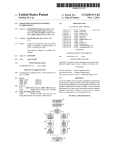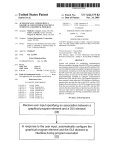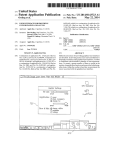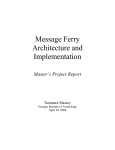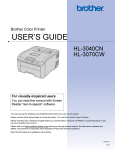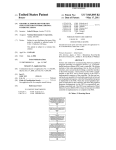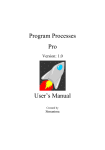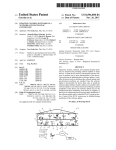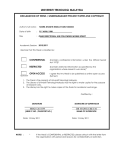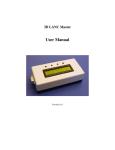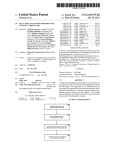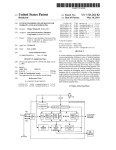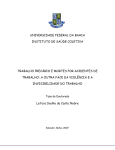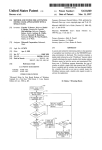Download Dynamic range assessment in block diagram systems
Transcript
USOO8812269B1 (12) Unlted States Patent (10) Patent N0.2 Oro?no, II (54) (75) (45) Date of Patent: DYNAMIC RANGE ASSESSMENT IN BLOCK 6,064,409 A 6,226,787 B1 5/2001 Serra et a1. 6,282,699 B1 8/2001 Zhang et 31. 6,330,356 B1* 12/2001 Sundareswaran et a1. Inventor: Donald Paul Oro?no, II, Sudbury, MA Assignee: The MathWorks, Inc., Natick, MA (Us) . (*) . . . 382/154 6,335,741 B1 1/2002 Nook 6,412,106 B1 * 6/2002 Leask et a1. ................. .. 717/124 6,715,139 B1 3/2004 Kodosky et a1. 6,748,583 B2 6/2004 AiZeIlbud-Reshef et 81. 6,971,065 Subject to any dlsclalmer, the term ofthls patent IS extended or adjusted under 35 U.S.C. 154(1)) by 1012 days. _ _ _ _ B2 11/2005 Austin 6,988,262 B1 * 7,051,322 B2 7,058,950 B2* 1/2006 Mallory et al‘ “““““““ n 717/127 5/2006 Rjoux 6/2006 charaman .................. .. 718/104 7,062,779 B1 6/2006 Thls patent IS 511131601 to a terminal dls- 7,072,801 B2 7/2006 James claimer, 7,072,813 B2 * 7/2006 7,076,740 B2 7/2006 Santori et al. (21) Appl. No.: 11/137,006 Filedr 5/2000 Thomsen et a1. 6,817,010 B2 * 11/2004 Aizenbud-Reshef et al. 717/127 6,839,894 B1 1/2005 Joshi et a1. . Not1ce: _ (22) *Aug. 19, 2014 DIAGRAM SYSTEMS (US) (73) US 8,812,269 B1 Courtney et a1. BillemaZ et al. ................ .. 703/6 (Continued) May 24, 2005 FOREIGN PATENT DOCUMENTS Related US. Application Data WO (63) Continuation-in-part of application No. 11/011,298, 99/09473 Al 2/1999 OTHER PUBLICATIONS ?led on Dec. 13, 2004. RedHaWk NightStar Tools Version 1.1 Release Notes, pp. 1-17, Sep. (51) Int. C1. G06F 17/50 (2006.01) . 6an 9/44 (2006.01) (Commued) (52) IcJEse (58) 2002* .................................. .. G06F 8/34 (2013.01) Prir/“ry Emmi/er T 011.1“ Fernandez. Riv.“ USPC ................ .. 703/1; 703/22; 714/731; 719/328 Amm’” Examlw T Klbrom Gebres?assw Field of Classi?cation Search (74) Attorney, Agent, or Firm * Harrlty & Harrlty, LLP USPC ....... .. 717/105,124,125, 127, 1304132, 153, 717/167; 715/763, 764 See application ?le for complete search history. (56) (57) ABSTRACT Remote monitoring tools are provided for non-intrusively and synchronously interacting With graphical models. The remote monitoring tools are dynamically connected to the graphical References Clted model Without requiring the addition of components to the model de?nition. The remote monitoring tool can perform dynamic range assessment on the graphical model. U.S. PATENT DOCUMENTS 5,061,245 A 10/1991 Waldvogel 5,331,111 A 7/1994 O’Connell 5,946,485 A * 8/1999 Weeren et a1. .............. .. 717/109 35 Claims, 10 Drawing Sheets Provide Graphical Model l Connect Remote Monitoring Tool to Graphical Model g l Observe! Collect Data 84 l If so Con?gured, Reglster Data Collected g l Perform Dynamlc Range Assessment 88 Repeat as Necessary to Debug 2Q US 8,812,269 B1 Page 2 (56) References Cited U_S_ PATENT DQCUMENTS 7,134,090 B2 11/2006 Kodosky et al‘ 2004/0210798 A1 10/2004 Higashi 2004/0255269 A1 12/2004 Santoriet al. 2005/0144587 A1 6/2005 Bryant 2005/0183098 A1 2006/0041859 A1 8/2005 Ilic et al. 2/2006 Vrancic et al. 7,171,653 B2* 1/2007 Albrecht ..................... .. 717/124 2006/0053211 A1 3/2006 Kornerup er a1~ 7,185,315 B2 2/2007 Sharp et al‘ 2006/0064670 A1 3/2006 Linebarger et al. 7,200,838 B2 4/2007 Kodosky et 31, 2006/0111074 A1* 5/2006 Petilliet al. ................. .. 455/334 7,210,105 B2 * 4/2007 2006/0129371 A1 * 6/2006 7,210,117 B2 4/2007 Kudukoli et 31‘ 2006/0184410 A1 8/2006 Ramamurthy et al. Melamed et 31, ,,,,,,,,,,, n 715/779 7215270 131* 7,302,675 B2* 5/2007 Kozak et 31, ,,,,,,,,,,,,,,,, n 341/143 11/2007 Rogers et al. .. . 717/125 7,302,676 B2* 11/2007 7,315,791 B2 7,325,210 B2* 7,439,891 B2 * 2006/0259870 A1 2007/0143455 A1 Oro?no et al. ................ .. 703/22 11/2006 Hewitt et al. 6/2007 Gorman etal Schmitt etal. .............. .. 717/132 Zoos/0007332 A1* 1/2008 1/2008 Hie et al‘ 1/2008 Rao etal. .................... .. 716/113 2008/0028196 A1* 2008/0098349 A1 1/2008 Kailas ......................... .. 712/245 4/2008 Lin et a1~ 2008/0222620 A1 * 9/2008 7,480,906 B2 1/2009 Joffrain et 31‘ 2009/0012757 A1* 1/2009 Oro?no et al. 7,490,029 132* 7,512,931 B2 2/2009 Wasynczuk et 31, ,,,,,,,,,, H 703/17 3/2009 Schmit 2009/0132993 A1* 2009/0216546 A1* 5/2009 Mani et al. 717/105 8/2009 Huang et al. .................... .. 705/1 2010/0223564 A1 9/2010 Hsu et al. 7,568,017 B2 10/2008 Kozak et 31, ,,,,,,,,,,,,,,,, n 341/143 Dubowsky ~~~~~~~~~~~~~~~~~~ ~- 330/129 7/2009 Shah et a1, Little et al. .................. .. 717/149 7,813,825 132* 10/2010 Dubowsky ,,,,,,,,,,,,,,,,,,,, H 700/94 2011/0023019 A1 1/2011 Aniszczyk et al. 7,827,068 B2 11/2010 Shah et al‘ 2011/0214044 A1 9/2011 Davis et a1. 7,835,895 B1* 11/2010 Oro?no etal. ................ .. 703/13 2012/0066762 A1 3/2012 Todorovw 7,966,562 B1 7,996,513 B2 8,046,708 B1 6/2011 Brewton et a1, 8/2011 Gorman et al‘ 10/2011 Aldrich 2013/0198527 A1 2014/0053090 A1 2014/0059525 A1 8/2013 Lu et al. 2/2014 Lu et a1. 2/2014 Jawa et al. 8,423,326 B1* 2002/0049934 A1* 4/2013 Astol? etal. ................... .. 703/1 4/2002 Anderson et al. .. 714/45 703/2 2014/0059573 A1 2/2014 Jawa etal OTHER PUBLICATIONS 2002/0052725 A1* 5/2002 Wasynczuk et al. .......... .. 703/22 2002/0054101 A1* 5/2002 Beatty ......................... .. 345/764 LabVIEWUserManual,Nati0nal Instruments, Jan. 1998Edition, pp. 2002/0070968 2002/0143857 2003/0005180 2003/0016206 2003/0037322 2003/0046663 A1 6/2002 Austin et al. A1* 10/2002 Bidamhalliet 31~ ~~~~~~~~ ~~ 709/203 A1 1/2003 Schmit et al. A1 100% Taitel A1* 2/2003 Kodosky et al. ............ .. 717/162 A1* 3/2003 11°qu étal ~~~~~~~~~~~~~~~ ~~ 717/125 1-514, Part No. 3209999B-01.* NightSim User’s Guide, Concurrent Computer Corporation, pp. 2003/0084127 2003/0093239 2003/0107595 2003/0200076 2004/0031019 2004/0032429 A1 A1 A1 A1 A1 A1 Remote Monitoring and Control System” pp. 509-511, IEEE 2000* SIMULINK model-based and system-based design, Version 5, pp. i_XXii, l_lt01_18,2002‘* Using Simulinkversion 5, pp, 1476, 2002* . “ . . Nat10nal Instruments, LabVIEW, Graphlcal Programm1ng for 500% 500% 6/2003 10/2003 2/2004 2/2004 Bu‘ihlrala et 31' S?hmlt Clol? Kodosky et al. Lamanna et al. Shah et al‘ 1_136,Sep,2002,* RedHaWk Linux Real-Time Software Environment, Concurrent Computer Corporation, pp, p2, 2002* W. Mansor, Z. Awang, and M. Taib, “Software Methodology for 2004/0034696 A1 2/2004 Joffrain et 31‘ Instrumentatlon,” User Manual, 34 pages, (1996). 2004/0045009 2004/0064750 2004/0093197 2004/0153997 3/2004 4/2004 5/2004 8/2004 International Search Report for PCT/U S2005/045493,4pages, dated Apr- 25, 2007 , Summons tOAttendOral Proceedings forApplicationNo.05854256. 4, 14 pages, dated Nov. 28, 2012. A1* A1 A1* A1* Bryant ,,,,,,,,,,,,,,,,,,,,,,,, n 719/316 Conway Billemaz et al. ,,,,,,,,,,,,,, ,, 703/ 13 Anderson et al. ,,,,,,,,,,, ,, 717/127 2004/0205726 A1* 10/2004 Chedgey et al. ............ .. 717/125 2004/0210426 A1 10/2004 Wood * cited by examiner US. Patent Aug. 19, 2014 Sheet 1 0f 10 CPU Display Device ? ?? Keyboard Mouse m 9'22 Electronic Device iQQ Primary Storage m Secondary Storage ? Network Interface M Modeling/Simulation Application (Simulink®) Fig. 1 US 8,812,269 B1 US. Patent Aug. 19, 2014 US 8,812,269 B1 Sheet 2 0f 10 52 m 85. :.E 2 N Eis“2 £3 2 am: ,‘£295.83 isaz FE FE E KimHE 5%28HEB52%in:3mm K2 2N35 .8 M T. Rios x =2. Ft KO E.3 US. Patent Aug. 19, 2014 Sheet 3 0110 198 "\ US 8,812,269 B1 r11 Fig. ZB = -—>' —~ Model is not running * Q User starts Model Execution gg Remote Monitroing Tool Execumn registers listener(s) com (gates With .218 moddel for t 3 Spam “5"; 9 even _ ‘ ‘ Model Execution | * occurs vyhich. Remote Monitoring 622315;? :génglgig?g Tool removes methods listener(s) from model ? ' 2.4 Event Handling: Listen reads data from Encountered model or the model and Dynamic Range Assessment IS block methods that has registered pe'fgamw _ li'stener(s) . §§ Send event to invoke _ Flg' 3 listeners synchronously with model execution Q ~— US. Patent Aug. 19, 2014 Sheet 5 0110 US 8,812,269 B1 US. Patent Aug. 19, 2014 Sheet 6 0110 18: File US 8,812,269 B1 EIiPE Edit View insert Iools Ilielp "1111 Fig, 5 US. Patent Aug. 19, 2014 Sheet 7 0f 10 [—30 IIiEE Elle git ylew Insert louls Desktog Window Help? DIDQIX%_%22 E A: - WWV Decadar i_ Q SM d Dam =-- 2 wwv MAWG Decoder AGC Envelope Detention g 5 g--§ Leadan Edga Darech El Gymwr new ll" Rlulur Dulgn II-I‘fennlnaiu LE What'a WWW 32—) US 8,812,269 B1 "Isaémin 11% US. Patent Aug. 19, 2014 Sheet 8 0110 Provide Graphical Model Q Connect Remote Monitoring Tool to Graphical Model Q Observe / Collect Data 84 If so Con?gured, Register Date Collected Q Perform Dynamic Range Assessment 88 Repeat as Necessary to Debug 90 Fig. 7 US 8,812,269 B1 US. Patent Aug. 19, 2014 Sheet 9 0110 US 8,812,269 B1 /—150 E El Fiie Edlt Tools Help llllilililllllllLl " - f /--- 160 Paste CODY Delete Highlight to Source Highlight to Destination Remove Highlighting 162 164 166 1- Open Viewer Connect to Viewer Disconnect VIewer -Create View US. Patent Aug. 19, 2014 Sheet 10 0110 Storage Device Fig. 9 US 8,812,269 B1 US 8,812,269 B1 1 2 DYNAMIC RANGE ASSESSMENT IN BLOCK DIAGRAM SYSTEMS response (“outputs”), the system’s input stimuli (“inputs”) at that time, the current state of the system, the system param eters, and time. The state of the system may be thought of as a numerical representation of the dynamically changing con CLAIM OF PRIORITY ?guration of the system. For instance, in a physical system modeling a simple pendulum, the state may be viewed as the This application is a continuation in part of Ser. No. current position and velocity of the pendulum. Similarly, a signal-processing system that ?lters a signal would maintain 11/011,298 entitled “Tools for System-Level Design Envi ronments” ?led on Dec. 13, 2004. a set of previous inputs as the state. The system parameters are the numerical representation of the static (unchanging) con ?guration of the system and may be viewed as constant coef ?cients in the system’ s equations. For the pendulum example, a parameter is the length of pendulum and for the ?lter example; a parameter is the values of the ?lter taps. FIELD OF THE INVENTION The present invention relates to a system and method suit able for non-intrusively monitoring data synchronous with events in an executing block diagram or graphical model and more speci?cally on performing dynamic range assessment Generally, graphical analysis and modeling methods, such as the block diagram method, are used in modeling for design, on the monitored data. analysis, and synthesis of engineered systems. The visual BACKGROUND OF THE INVENTION Historically, engineers and scientists have utilized graphi 20 cal models in numerous scienti?c areas such as Feedback Control Theory and Signal Processing to study, design, debug, and re?ne dynamic systems. Dynamic systems, which locations of the model, or to observe how data is transformed are characterized by the fact that their behaviors change over time, are representative of many real-world systems. Graphi cal modeling has become particularly attractive over the last 25 few years with the advent of software packages, such as Simulink®, made by The MathWorks, Inc. of Natick Mass., LabVIEW®, made by National Instruments Corporation of Austin, Tex., and the like. Simulink® provides sophisticated software platforms with a rich suite of support tools that interest. Currently, block diagram environments offer “scope” blocks to be used in such situations, with each scope connected to a signal of interest in the model. Alternatively, environments such as Real-Time Workshop® (manufactured by The MathWorks, Inc. of Natick Mass.) offer interfaces to methodical, and cost-effective. A dynamic system (either natural or man-made) is a system 35 various data values of the model, such that an individual can non-intrusively observe the data values. In many systems, the dynamic range of values appearing within the system is of interest when verifying operation of the system. For example, some system components which range from simple to highly complex systems. Physical dynamic systems include a falling body, the rotation of the earth, bio-mechanical systems (muscles, joints, etc.), bio chemical systems (gene expression, protein pathways), through the model. Examples of such data values include signal values, states, work areas, and parameters. Signal dis plays used in conjunction with a system-level design environ ment, such as Simulink®, often require multiple display mechanisms to be associated simultaneously with multiple signals to monitor the progress of a model at various points of 30 makes the analysis and design of dynamic systems ef?cient, whose response at any given time is a function of its input stimuli, its current state, and the current time. Such systems representation allows for a convenient interpretation of model components and structure and provides a quick intuitive notion of system behavior. During the course of modeling and simulation, it is often desirable to be able to observe particular data values at certain 40 take as input numeric values that change over time may oper weather and climate pattern systems, etc. Examples of man made or engineered dynamic systems include: a bouncing ate properly only if the inputs fall within a prescribed numeri cal range; system performance may be negatively impacted if ball, a spring with a mass tied on an end, automobiles, air the values fall outside the range. In this example, knowledge of the dynamic range of input values under situations of interest is an important characterization of the system. planes, control systems in major appliances, communication networks, audio signal processing, nuclear reactors, a stock market, etc. 45 Dynamic range is a ratio of the maximum data value to the minimum data value. Typically, mechanisms used to retain values within a dynamic system have associated with them limits on their maximum dynamic range. The dynamic range Professionals from diverse areas such as engineering, sci ence, education, and economics build mathematical models of dynamic systems in order to better understand system behavior as it changes with the progression of time. The mathematical models aid in building “better” systems, where “better” may be de?ned in terms of a variety of performance measures such as quality, time-to-market, cost, speed, size, power consumption, robustness, etc. The mathematical mod els also aid in analyzing, debugging and repairing existing systems (be it the human body or the anti-lock braking system 50 limit can arise from several sources: constraints imposed on system components such that they operate within a prescribed speci?cation, for interoperability, safety, or performance rea sons; a physical limitation on the operation of an analog system component, such as saturation limits on an analog 55 ampli?er; or storage considerations of digital system compo nents, whereby values can be accurately retained only if they in a car). The models may also serve an educational purpose fall within prescribed range limits. These examples are rep of educating others on the basic principles governing physical resentative and by no means exhaustive. Failure to adhere to systems. The models and results are often used as a scienti?c communication medium between humans. The term “model based design” is used to refer to the use of graphical models 60 in the development, analysis, and validation of dynamic sys the system is thus of great importance. However, conventional non-intrusive approaches to observing the various data elements, such as dynamic range, tems. Dynamic systems are typically modeled in model environ ments as sets of differential, difference, and/or algebraic such dynamic range limits can lead to poor system perfor mance, incorrect system operation, or overall system failure. Assessment of the dynamic range of values occurring within equations. At any given instant of time, these equations may do not allow users to observe the data synchronously with the various execution events in the block-diagram or other oper be viewed as relationships between the system’s output ating model. Such synchrony is necessary in many scenarios 65 US 8,812,269 B1 3 4 because data values may be not be in a deterministic observ The callbacks may be implemented using one of block dia able state at all times during model execution. An example of such a scenario is when a signal memory location is reused by gram primitives and textual language primitives. multiple blocks for ef?ciency reasons. Furthermore, allowing supporting a graphical modeling environment, a method of synchronous observation of the data also ensures that observ ers of the data are operating optimally, for example when the debugging a model using a remote monitoring tool is pro vided. The method comprises connecting at least one moni data values are refreshed. toring tool to the graphical modeling environment prior to In accordance with another aspect, in an electronic device execution, during execution, or after execution of the model. SUMMARY OF THE INVENTION The method continues with operating the at least one moni toring tool to perform dynamic range assessment on data of interest of the model. Based on the results of the dynamic range assessment, the model may then be modi?ed. Further There is a need in the art for a design tool that interacts with an executing model in a manner that is non-intrusive, but that is also synchronized with the model as the model executes. The interaction can be decoupled from the model as a remote monitoring tool, which can observe data from or for the model as it executes and perform dynamic range assessment using the observed data. The present invention is directed toward further solutions that address this need. In accordance with various aspects of the present inven tion, a remote monitoring tool is provided. The monitoring monitoring can then be performed. In accordance with another aspect, a system for generating and displaying a graphical modeling application is provided. The system comprises a distribution server and a client device in communication with the distribution server. The distribu tion server provides to the client device, a remote monitoring 20 tool for performing dynamic range assessment. tool can non-intrusively collect data of interest of a model. In accordance with another aspect, in a network having a Data of interest can be dynamically selected for monitoring. server, executing a graphical modeling environment, and a The monitoring tool can initiate an action upon occurrence of client device in communication with the server, a method is a predetermined execution event of the model. Data of inter est may also be dynamically selected upon occurrence of a provided. The method comprises selecting, at the server from the client device, data of interest of a model in the graphical 25 condition. The monitoring tool can access at least one of data modeling environment; invoking the remote monitoring tool and an event of the model using one of block diagram primi synchronously with model execution in the graphical model ing environment; performing dynamic range assessment on the data of interest using the remote monitoring tool; and tives and textual language primitives. In accordance with one embodiment of the present inven tion, in a graphical modeling environment operating on an electronic device, a method of using a remote monitoring tool 30 includes connecting it to the graphical modeling environment prior to execution, during execution, or after execution of a model. The method continues with operating the at least one remote monitoring tool to perform dynamic range assess ment. The remote monitoring tool is detachable from the model during execution of the model in the graphical model BRIEF DESCRIPTION OF THE DRAWINGS 35 The present invention will become better understood with reference to the following description and accompanying drawings, wherein: ing environment. In accordance with one embodiment of the present inven tion, a medium is provided for use in a graphical modeling outputting, from the server to the client device, the result of the dynamic range assessment. 40 FIG. 1 is a is a diagrammatic illustration of an electronic device that can be utilized to execute a method performed in environment on an electronic device. The medium holds an embodiment of the present invention; instructions executable using the electronic device for per forming a method of using a remote monitoring tool. The method includes connecting at least one remote monitoring tool to the graphical modeling environment prior to execu tion, during execution, or after execution of a model. The FIG. 2A is a screen depiction of an example model that can make use of the tool and method according to one aspect of the present invention; 45 FIG. 2B is another embodiment of model block having a symbol indicating a connected remote monitoring tool. method continues with operating the at least one remote FIG. 3 is a diagrammatic illustration of a method of use of monitoring tool to perform dynamic range assessment. The remote monitoring tool is detachable from the model during execution of the model in the graphical modeling environ the tool, in accordance with embodiments of the present invention; 50 ment. In accordance with one example embodiment of the present invention, the at least one remote monitoring tool can be implemented using block diagram primitives. These primitives are aggregated into the block-diagram automati cally prior to execution by the modeling environment. In accordance with one example embodiment of the present invention, the at least one remote monitoring tool can be implemented as an event-listener application program ming interface (API). This API can provide a non-intrusive 55 FIG. 4D is a screen depiction of toolbar embodiment of FIG. 4C depicting another state of a remote monitoring tool. FIG. 5 is a screen depiction of multiple displays for a tool, 60 primitives. be implemented as a set of callbacks. These callbacks are invoked synchronously with block-diagram execution events. FIG. 4C is a screen depiction of another toolbar embodi ment of the example tool of FIG. 4A depicting one state of a remote monitoring tool. and synchronized interface. The listener may be implemented using one of block diagram primitives and textual language In accordance with one example embodiment of the present invention, the at least one remote monitoring tool can FIG. 4A is a screen depiction of an example tool, according to one aspect of the present invention; FIG. 4B is a screen depiction of the toolbar of the example tool of FIG. 4A; according to one aspect of the present invention; FIG. 6 is a screen depiction of multiple displays, according to one aspect of the present invention; FIG. 7 is a ?owchart illustrating an example method of use of the tool, in accordance with embodiments of the present 65 invention; and FIG. 8 is a screen depiction of context sensitive menus used to connect the tool to a model. US 8,812,269 B1 6 5 FIG. 9 illustrates a client-server environment suitable for cating with one or more electronic devices external to the practicing an illustrative embodiment of the present invention electronic device 500 depicted. A modem is one form of network interface 514 for establishing a connection with an external electronic device or network. The CPU 502 has either internally, or externally, attached thereto one or more of DETAILED DESCRIPTION the aforementioned components. In addition to applications An illustrative embodiment of the present invention relates to a remote monitoring tool and corresponding method of use. previously mentioned, modeling applications, such as Sim The remote monitoring tool is con?gured to perform dynamic ulink® 516, can be installed and operated on the electronic device 500. It should be noted that the electronic device 500 is merely range assessment. The remote monitoring tool is non-intru sively and synchronously connected to a graphical modeling environment prior to execution, during execution, or after representative of a structure for implementing the present invention. However, one of ordinary skill in the art will appre ciate that the present invention is not limited to implementa tion on only the device 500 as described herein. Other imple mentations can be utilized, including an implementation execution of a model. The remote monitoring tool is detach able from the model during execution of the model in the graphical modeling environment. The remote monitoring tool is non-intrusive to the graphi cal model, such that the remote monitoring tool is not embed ded in the model in the same way that other elements of the based partially or entirely in embedded code, where no user inputs or display devices are necessary. Rather, a processor can communicate directly with another processor or other device. model are interconnected and embedded. In the case of a graphical model using blocks and signals, the user does not add blocks or signals to the model diagram when attaching a remote monitoring tool in accordance with the present inven tion to the model. Rather, data of interest is selected for 20 monitoring, and during execution the model informs the remote monitoring tool of events of which the tool has requested to receive noti?cation. The process of sending an 25 Turning now to example embodiments of the present invention, the method and system of the present invention operate in a block diagram modeling environment, such as that of Simulink®. The block diagram modeling environment is otherwise referred to herein as the graphical model. One of ordinary skill in the art will appreciate that there are a number event can be achieved through, but not limited to, an event of different graphical modeling and simulation applications listener application programming interface (API), a callback based interface, and/or model and remote monitoring tool that make general use of blocks or other graphical represen tations to model or simulate conditions, events, designs, operations, and the like, or to model and control events imple mented on hardware devices, and the like. Accordingly, the present invention is intended for use on all such modeling aggregation for execution. The remote monitoring tool can work with execution modes that include but are not limited to interpretive, accelerated, or generated code model execution modes. FIGS. 1 through 9, wherein like parts are designated by like reference numerals throughout, illustrate example embodi ments of a remote monitoring tool capable of performing dynamic range assessment, and corresponding method of use, according to the present invention. Although the present invention will be described with reference to the example embodiments illustrated in the ?gures, it should be under stood that many alternative forrns can embody the present invention. One of ordinary skill in the art will additionally appreciate different ways to alter the parameters of the 30 applications. The present invention is generally directed to a system and method for interacting non-intrusively, yet synchronously, 35 with a graphical model. FIG. 2 is a screen depiction of a graphical model 10 simulating a dynamic process. FIG. 2 shows a version of a time-based or event-based block diagram 40 graphical model 10. As referred to herein, graphical model 10 is intended to encompass multiple variations of graphical model. Graphical model 10 is formed generally of a plurality of blocks 11 that pass signals 13 to represent a dynamic system. The particular use or purpose of the graphical model embodiments disclosed in a manner still in keeping with the 10 can vary to include anything that can be modeled using a spirit and scope of the present invention. graphical modeling environment. Thus, the present invention FIG. 1 illustrates one example embodiment of an electronic 45 device 500 suitable for practicing the illustrative embodi ments of the present invention. The electronic device 500 is representative of a number of different technologies, such as In the example embodiment, time-based graphical models personal computers (PCs), laptop computers, workstations, personal digital assistants (PDAs), Internet appliances, cellu is not limited to the speci?c example embodiments discussed herein, as understood by one of ordinary skill in the art. 50 10 have blocks 11 connected by signals 13. Blocks 11 are responsible for computing the values of signals 13 as time progresses. The arrows denote the computational direction of lar telephones, and the like. In the illustrated embodiment, the the signal. Input ports read signals and output ports write electronic device 500 includes a central processing unit signals. The user of the present invention may wish to obtain a reading of a value of one of the signals 13 in the graphical (CPU) 502 and a display device 504. The display device 504 enables the electronic device 500 to communicate directly with a user through a visual display. The electronic device 500 further includes a keyboard 506 and a mouse 508. Other model 10, or of one of the processes in one of the blocks 11. 55 potential input devices not depicted include a stylus, track ball, joystick, touch pad, touch screen, and the like. The illustrated in the ?gure, conventional modeling applications electronic device 500 includes primary storage 510 and sec ondary storage 512 for storing data and instructions. The storage devices 510 and 512 can include such technologies as a ?oppy drive, hard drive, tape drive, optical drive, read only memory (ROM), random access memory (RAM), and the like. Applications such as browsers, JAVA virtual machines, However, in the graphical model 10 illustrated, there is no instance of a scope shown with the model. Accordingly, if the graphical model 10 is running a model execution at the time in the situation illustrated have no mechanism for a user to be 60 able to take readings of signal or internal block/model states synchronously. However, with the remote monitoring tool of the present invention in accordance with one embodiment, an event listenerAPI or equivalent tool is provided to associate the tool and other utilities and applications can be resident on one or 65 with the graphical model 10 without being embedded in the both of the storage devices 510 and 512. The electronic device 500 can also include a network interface 514 for communi graphical model 10. For example, if the user wishes to know the value of the signal at point A in the graphical model 10 for US 8,812,269 B1 7 8 the purpose of performing dynamic range assessment, the user implements the remote monitoring tool of the present in a physical hardware device, such as memory locations in a processor, a physical I/O protocol for a processor or an FPGA or ASIC, or some other de?ned method for data delivery, as invention to initiate an observation event. The user registers with the model, using the event-listener API, a request to invoke the monitoring tool when point A in the graphical model 10 is computed by the source block of the signal of understood by one of ordinary skill in the art. A unique identi?er can be provided for each signal in the graphical pointA. As the model is executing, when the signal at pointA with any signal or group of signals. Methods to read signal data via the unique identi?er, which can be synchronized by the pre-execution and/or post-execution callback or event, model 10 or hardware, such that the tool can be associated is re-computed by the source block of the signal, an event is sent to the listener. The listener in this illustrative example reads the value of the signal at pointA which can then be used can be provided. Furthermore, textual, graphical, audio, in assessing dynamic range at that point in the model. It should be noted that throughout this description the example visual, tactile, or other data rendering techniques and capa bilities supported by, or interfaced to, the modeling environ embodiments make use of an API form of tool to connect the ment can be provided, such that the signal data is presented to remote monitoring tool to the model. However, one of ordi nary skill in the art will appreciate that the remote monitoring tool does not need to be implemented in the form of an API, but rather, can be implemented using a number of different user in a discemable manner. The remote monitoring tool can include different types of tools, such as display scopes, strip chart recorder, an oscillo scope, a spectrum analyzer, a 2-port network analyzer, a logic signal display, a waterfall plot, a communications constella tion plot, an audio output device, and a video display device. tools, including library based modules, and other tools. As such, references to an API in the present description are intended to include APIs as well as such other equivalent tools noted above. In addition, an alternative example embodiment of the present invention makes use of an aggregation pro gramming paradigm to achieve the non-intrusive and syn chronized behavior of the remote monitoring tool. The remote monitoring tool does not need to be repre 20 25 sented graphically in the graphical model 10. However, because the remote monitoring tool registers listeners with system for processing. One of ordinary skill in the art will appreciate that the present invention is not limited to using the event-listenerAPI to non-intrusively and synchronously con nect the remote monitoring tool(s) to the model. Ideally, the monitoring tool is used in performing dynamic range assessment on the monitored system. Dynamic range the model, the model can insert a graphical symbol or text, such as symbol 19 in FIG. 2A, or other representation in the graphical model 10 showing the existence of the listener for the remote monitoring tool. Such graphical representation can be, for example, shown in the block 11, indicating the The monitoring tool can also be a non-graphical tool, such as a tool that reads the model data (such as the signal at point A of the illustrative model 10) and sends the data to another 30 assessment may take place during the design and simulation phase of building a system, when the model of the system is being created. It may take place during the test of subsystems of the simulation system, or as a test on the completed simu made by the remote monitoring tool can be described by lation system. It may also take place on the actual system produced, such as a DSP implementation of a signal process ing system. This latter case may be accomplished by commu nication with the ?nal hardware system, such as in hardware selection of one or more signals 13 from a list of all available in-the-loop (HIL) test systems. signals 13 in the graphical model 10. The remote monitoring The number of nodes within a block diagram that are tracked within a system as part of a dynamic range assessment remote monitoring tool is connected to the internal state of the block 11 and not the signal 13. More speci?cally, in the illustrative example showing the symbol 19, connections tool can also be described by the direct entry of an identi? cation of one or more signals 13 in the graphical model 10. The connections can be highlighted at some point in time, to 35 40 can vary widely, depending on the particular assessment being conducted. The assessment can be a partial character associate a symbol 19 with one or more selected signals 13. ization ofjust a single component or just a single computation For example, this can be accomplished by pressing a button in of interest within a single component; it might be across a the display interface, with the corresponding signal 13 in the model highlighted by color, blinking, or other temporary or subsystem of components for a speci?c operation; it might be 45 persistent graphical indication, in addition to textual or other representations. The connection can also be highlighted by a graphical affordance in the graphical model 10, such as a “test type); or across all values produced within an entire system as a whole. point” symbol (small ‘lollipop’ icon) connected to a signal line for as long as the virtual connection remains. For con nections to internal block state as in the illustrative block 11, The digital implementation of a system is of particular 50 the connections can be created in similar fashion to signal selection, except that a block 11 is selected. Likewise the connection of a remote monitoring tool to a block 11 may be represented by “test point” symbol 1911, an example of which cessor (GPP, DSP, etc), a predetermined number of storage 55 The remote monitoring tool can be connected to the model out the course of simulation) may be of interest for charac terization. Of even greater interest is the characterization of dynamic values, that is, values that are subject to change post-execution callbacks or events associated with any of the methods of the computational blocks in the graphical model likewise be provided where the de?nitions refer to data nodes locations allocated for this purpose within anASIC or FPGA, or other temporary or permanent storage mechanism exhib iting a constraint on the number of bits used to represent a numeric value. Dynamic range characterization of constant values (that is, values that are certain to remain ?xed through 60 monitoring tool in accordance with the present invention, includes the presence of user-de?nable pre-execution and/or 10, such that the callback or event enforces proper synchro nization for data transfer to and from the tool. Such anAPI can interest. The dynamic range constraint often arises from a pre-selected number of bits used to represent values within a digital system, the storage location being an address in a computer memory or a register of certain size within a pro can be as seen in FIG. 2B. 10 using an event-listener API. More speci?cally and in accordance with an example embodiment of the present invention, the API that enables the practice of the remote characterization of a class of components having certain sys tem characteristics (such as all components of a particular 65 during the course of simulation. In another embodiment, it may be desirable to change the implementation of a system, in which the mechanisms used to retain values within the system (such as a set of pre-de?ned data types) impose limits on the representation of dynamic US 8,812,269 B1 10 range. An example of this is the change from ?oating-point to Another example toolbar 15 can be seen in FIGS. 4C and 4D. In this implementation the toolbar 15 has a button for ?xed-point numeric representation of digital values. Typically the types of measurements made for dynamic connecting and disconnecting a remote monitoring tool. They range assessment include minimum and maximum values button may also indicate the current state of connectivity for the remote monitoring tool. In FIG. 4C the button 17a indi observed at the node(s) monitored by the remote monitoring tool as well as histograms of the data being monitored. In cated that the remote monitoring tool is currently discon some embodiments mean values may be determined. In cer nected and the user may click the button 17a to connect the tain embodiments, the remote monitoring tool may also be con?gured to monitor the number of times a speci?c set of threshold values has been crossed. Other possible con?gura remote monitoring tool. In FIG. 4D the button 17b indicates the remote monitoring tool has been connected and the user may click the button 17b to disconnect the remote monitoring tool. In addition, the remote monitoring tool interface in a par ticular embodiment can vary. For example, in FIG. 5, the remote monitoring tool is implemented as a multiple docu tions and measurements will apparent to one skilled in the art given the bene?t of this disclosure. In addition, the displays of the remote monitoring tool, if required, are provided separate from the graphical model 10, thus keeping with the non-intrusive feature of this invention. ment interface (MDI) style GUI design, incorporating mul Likewise, a GUI can be provided with a multiple-document interface type of layout in which a master GUI contains one or tiple display devices in a single master window 18. In this example, there are connections established for each display more visual display device windows with additional inter corresponding to signals originating from multiple graphical faces for managing the connections to the model correspond ing to each remote tool. 20 models 10. A ?rst display 20 reports data from a ?rst graphi cal model. A second display 22 reports data from a second graphical model. A third display 24 and a fourth display 26, report data from a third and fourth graphical model. The remote monitoring tool is formed of the collection of the 25 displays 20, 22, 24, and 26. Each of the displays operates independently and pulls data from different model locations. Several example embodiments of implementations of the remote monitoring tool in accordance with the present inven tion are described herein. In addition, FIG. 3 is a diagram matic illustration of a method of using the remote monitoring tool realized using the event-listener API. In accordance with one example embodiment of the present invention, a user can attach a remote monitoring tool to a model to listen to speci?c The displays can pull data from the same model location if desired. Furthermore, as mentioned previously, each of the events before, during, or after model execution (step 50). The collection of the displays 20, 22, 24, and 26 forming the user can detach a remote monitoring tool before, during, or after graphical model (10) execution (step 52). Connections to the model (10) by the remote monitoring tool are main remote monitoring tool can be individually or collectively attached or detached from the graphical models before, dur tained while the model is not running (step 60). When the ing, or after the graphical models are implemented. model is not running (step 60), the user can edit the model and possibly change it structure. If the act of editing the model deletes an object such as a block (11) or line (13) that is connected to a remote monitoring tool, the tool becomes disconnected from the model. The user can start the model execution (step 62). During model execution model and block methods are invoked. Within Simulink® this consists of a simulation loop. Each computational block in Simulink® may contain multiple run time methods that are executed within the simulation loop. 30 FIG. 6 is another screen depiction of an MDI GUI 30 with 35 a remote connection manager 32. The remote connection manager 32 provides an organized GUI that enables a user to track and select different elements making up the remote 40 monitoring tool. One of ordinary skill in the art will appreci ate that the example remote connection manager 32 is shown as a tree structure. However, any number of ?le organization Simulink® decomposes block methods by type and executes them in a prede?ned manner from model models that are invoked by the simulation loop. During execution of a model or block method (step 64), if a block with registered listeners is encountered (step 66), the model sends an event (step 68) causing the remote monitoring tool to execute. Dynamic Range assessment can then be performed. When execution completes (step 70), the model returns to the not running state a pre-loaded collection of displays forming the remote moni toring tool, such as those illustrated in FIG. 5. In addition, the remote monitoring tool in this example embodiment includes 45 techniques and con?gurations can be utilized to generate the remote connection manager 32, such that the manager 32 is not limited to the speci?c embodiment illustrated. As described, the remote monitoring tool includes at least one tool. The remote monitoring tool is attached to the model in the graphical modeling environment prior to execution, 50 (step 60). One example implementation of the remote monitoring during execution, and/or after execution of a model. The remote monitoring tool is detachable from the model during execution of the model in the graphical modeling environ ment. tool of the present invention is shown in FIGS. 4A-4D. FIG. The monitoring tool non-invasively collects data after data 4A is a screen depiction of a tool resulting from the user of interest has been selected 10. The selection of the data of interest can be displayed in accordance with the examples illustrated herein. In addition, the remote monitoring tool can initiate an action upon selection of a predetermined charac teristic of the data or event observed. For example, if a pre implementing the remote monitoring tool. The remote moni 55 toring tool presents a histogram plot 12 showing dynamic range. The histogram plot is a visual display of the dynamic range for the graphical model at point A. The remote moni toring tool can include a number of different interfacing options, some of which can be implemented in a toolbar con?guration. For example, FIG. 4B shows a toolbar 14 hav ing a number of standard buttons. One of ordinary skill in the art will recognize there can be several button con?gurations. One example button that can be utilized in conjunction with the present invention is a highlight button 16 which when clicked on will highlight the signal in the graphical model 10 being displayed by the remote monitoring tool. determined data point, such as a maximum or a minimum, is 60 achieved in a graphical model as it is running, the remote monitoring tool can register the occurrence and forward instructions or implement other actions to address the occur rence. Such actions may include pausing the model execu tion, forwarding data relating to other points in the model at 65 the time of the occurrence, sending a message to the user, implementing a change in the operation of a separate model and/or hardware device, and the like. US 8,8l2,269 B1 11 12 The remote monitoring tool con?gurations can be saved in the graphical model, or can be saved separate from the graphi cal model. In addition, one of ordinary skill in the art will instrument the executable with entry points before and after the code for each model and block method, thus enabling one to implement the event-listener architecture enabling the removal and addition of remote monitoring tools during model execution. An alternative to the event-listener paradigm for synchro nously connecting the remote monitoring tool to the model is to aggregate the model objects and the remote monitoring appreciate that a reference or other identi?er to a speci?c remote monitoring tool can likewise be stored within the graphical model or separate from the graphical model being viewed or manipulated by the remote monitoring tool. Fur thermore, the selection of blocks, signals, or ports to be inter faced with the remote monitoring tool can be performed using tool(s) into one execution engine. This can be done when the connections to the model are made prior to model execution and are not altered during execution. The remote monitoring tool is not added to the graphical de?nition of the model; any available interface mechanism, including graphically, textually, data, and can be implemented through in-direct or direct connection to other software or hardware, and the like, rather, an internal aggregated representation of the model is formed consisting of both the model objects plus the remote monitoring tools. After this is done, an internal execution in addition to user interface. In the embodiments presented herein, the remote monitor ing tool con?gurations consist of the various attributes of the structure can be created by translating the model into execut able operations or generated code. If the connections are altered during execution, it is necessary to know a priori the tool the user has created. The tool can be connected to the model using an object selector. The object selector is one component of the remote monitoring tool that associates each tool the user has created with objects (e. g. blocks, signals, or ports) in the model. For example, the selection of model objects (blocks, signals, or ports) to be connected to a remote monitoring tool can be done using a signal selector that dis plays the model hierarchy in a textual fashion. The user navi gates to the desired object in the textual hierarchy and con nects the tool the object. Alternatively, the user can select an full range of alterations that may be performed. Otherwise, 20 dynamic alteration of the execution structure needs to occur and dynamic alteration of the execution structure is very similar to the event-listener paradigm. The examples to this point have focused primarily on the system where the graphical modeling environment was on a 25 local electronic device. The graphical modeling environment object in the model and then click a button in the signal selector to attach the remote monitoring tool to the selected may of course also be implemented on a network 900, as illustrated in FIG. 9, having a server 902 and a client device object. 904. Other devices, such as a storage device 906, may also be connected to the network. In one such embodiment a system for generating and dis It should be noted that one useful implementation of the remote monitoring tool of the present invention is in the 30 performance of debugging of a system being modeled using playing a graphical modeling application, comprises a distri the graphical model 10, as shown in FIG. 7. To debug an bution server for providing to a client device, a remote moni operating model, the model is ?rst provided (step 80). The toring tool for performing dynamic range assessment. Here user implements an instance of the remote monitoring tool (step 82). At this point, the remote monitoring tool can in?u the distribution server provides a client device, with a remote 35 This remote monitoring tool may be part of a tool set available ence the next steps. The user may attach the remote monitor ing tool at a point in the model at which access to data is to the client on the server. The client may then use the remote monitoring tool for performing dynamic range assessment, desired or collect data (step 84). If desired, the data collected can be registered (step 86). The remote monitoring tool can then perform dynamic range assessment (DRA) (step 88), monitoring tool for performing dynamic range assessment. 40 while still maintaining its non-invasive characteristics in the graphical model. The steps can be repeated as necessary to on a block diagram for a dynamic system. In another embodiment, the server may execute the graphi cal modeling environment. A user may then interact with the graphical modeling interface on the server through the client debug the model (step 90). device. In one example of such a system a server and client One skilled in the art will recognize that there are several ways to attach monitoring tools to a model. In one example shown in FIG. 8 as model 150, an alternative embodiment of device are provided. The server is capable of executing a graphical modeling environment. The client device is in com 45 munication with the server over a network. On the server from the client, data of interest to be monitored may be selected. The remote monitoring tool may then be invoked synchro the present invention can be used to connect or disconnect remote monitoring tools from the model 150. One can bring up the context sensitive menu for a signal 160 by right clicking on a signal, such as signal 161. Within the context nously with model execution in the graphical modeling envi viewers can be connected to one signal), disconnect one or all ronment. Dynamic range assessment may then be performed and the results outputted from the server to the client device. The remote monitoring tool provides freedom to tap into an existing and executing model at any time to collect data. of the viewers connected to the signal using a disconnect Accordingly, a user attempting to diagnose or debug a model 50 sensitive menu one can open a viewer that is connected to the signal using an open viewer selection 162 (note multiple selection 164, or create and connect a new viewer using a 55 of a dynamic system can use the remote monitoring tool of the create view selection 166. present invention to both take contemporaneous or real time When executing the model using an interpretive engine, the event-listener paradigm provides a straight forward means by readings of signal values within the graphical model and/or communicatively associated devices. One of ordinary skill in which to support the remote monitoring tool. However, one skilled in the art recognizes that a model can be translated to 60 generated code, where the generated code can be a high-level programming language such as C, Java, or C++ or assembly code. To support the adding and removing of remote moni example of debugging described herein. Rather, the present invention and corresponding method of use can vary in accor toring tools during execution, the generated code can be instrumented before and after each block method. Alterna tively, a run-time engine can be created which, using the executable created after compiling and linking the code, can the art will appreciate that debugging is an iterative process that can be implemented in a number of different ways, such that the present invention is not limited to the speci?c 65 dance with preferred debugging processes. Accordingly, the present invention is generally directed to a remote monitoring tool and corresponding method of use. The tool is non-intrusive, meaning there are no explicit mod US 8,812,269 B1 14 13 the non-invasively monitoring the data of interest being eling primitives (e.g. blocks or lines) added to the graphical performed by the device; model. Thus, there is no requirement that the tool be pro grammed into the model When the model is being created. The remote monitoring tool is furthermore remote and monitoring performing a dynamic range assessment based on moni toring the data of interest, the performing the dynamic range assessment being per formed by the device; determining, based on performing the dynamic range in nature, meaning that it is separate from the graphical model. The remote monitoring tool can be connected to the graphical modeling environment prior to execution, during assessment, a dynamic range associated With the data of execution, or after execution of a model, and is also detach able from the model during execution of the model in the interest, graphical modeling environment. the dynamic range including a maximum data value and a minimum data value, and Numerous modi?cations and alternative embodiments of the present invention Will be apparent to those skilled in the the determining the dynamic range being performed by art in vieW of the foregoing description. Accordingly, this the device; and description is to be construed as illustrative only and is for the purpose of teaching those skilled in the art the best mode for carrying out the present invention. Details of the structure providing a result of the dynamic range assessment for may vary substantially Without departing from the spirit of the the device. 2. The method of claim 1, Where receiving the information indicating the data of interest includes: receiving the information indicating the data of interest during the execution of the model. 3. The method of claim 1, Where receiving the information indicating the data of interest includes: receiving the information indicating the data of interest prior to the execution of the model. 4. The method of claim 1, Where receiving the information indicating the data of interest includes: present invention, and exclusive use of all modi?cations that come Within the scope of the appended claims is reserved. It is intended that the present invention be limited only to the display during the execution of the model, the providing the result for display being performed by 20 extent required by the appended claims and the applicable rules of laW. The invention claimed is: 1. A method comprising: 25 providing a user interface associated With a remote moni toring tool, the providing the user interface being performed by a receiving a selection of a portion of the model via the graphical modeling environment. device, and 30 the user interface enabling a user to: track and select one or more elements associated With an operation of the remote monitoring tool, and input con?guration information associated With the operation of the remote monitoring tool, the con?guration information being stored in a 6. The method of claim 1, Where the remote monitoring 7. The method of claim 1, Where the model includes a 35 40 45 environment, the remote monitoring tool being connected to the model via an event-listener application programming inter face, 50 enforcing a synchronization of data being trans ferred between the model and the remote monitor ing tool using one or more of: a pre-execution callback, a post-execution callback, or 55 an occurrence of an event associated With the data of interest, the invoking the remote monitoring tool being per formed by the device; executing the remote monitoring tool during the execution of the model, the executing the remote monitoring tool being per formed by the device; the non-invasively monitoring, via the event-listener appli cation programming interface, the data of interest based on the one or more of the pre-execution callback, the post-execution callback or the occurrence of the event, signal line, and Where receiving the information indicating the data of est being performed by the device; invoking the remote monitoring tool synchronously With the event-listener application programming interface block, and Where receiving the information indicating the data of interest includes: receiving a selection of the block. 8. The method of claim 1, Where the model includes a tool; an execution of the model in the graphical modeling tool is expressed using block diagram primitives. tool is expressed using textual programming primitives. model associated With the remote monitoring receiving, via the user interface, information indicating data of interest associated With the model, the model being provided via a graphical modeling envi ronment, and the receiving the information indicating the data of inter 5. The method of claim 1, Where the remote monitoring interest includes: receiving a selection of the signal line. 9. The method of claim 1, further comprising: indicating, based on the information indicating the data of interest, a selection of the data of interest, via a display of the model, using an indicator. 10. The method of claim 1, further comprising: indicating that a portion of the model is to be monitored during the execution of the model to collect the data of interest using an indicator displayed in conjunction With the portion of the model. 11. The method of claim 1, further comprising: storing a reference associated With the remote monitoring tool in the model; and Where invoking the remote monitoring tool includes: invoking the remote monitoring tool based on the refer ence. 60 12. The method of claim 1, Where the remote monitoring tool is included in a set of remote monitoring tools; Where non-invasively monitoring the portion of the model includes: monitoring, using another remote monitoring tool, 65 included in the set of remote monitoring tools, a por tion of another model. 13. The method of claim 1, Where the remote monitoring tool is expressed using block diagram primitives, and US 8,812,269 B1 15 16 Where invoking the remote monitoring tool synchronously determine, based on the dynamic range assessment, a With the execution of the model includes: dynamic range associated With the data of interest, aggregating the block diagram primitives and elements included in the model into an execution engine. 14. The method of claim 1, Where the event-listener appli 01 cation programming interface enforces the synchronization of the data being transferred using the group identi?ers and the occurrence of the event; and Where invoking the remote monitoring tool synchronously With the execution of the model includes: registering, using the listener application programming event-listener application pro gramming interface, inter est in speci?c execution events associated With the execution of the model. 15. The method of claim 1, Where invoking the remote monitoring tool synchronously With the execution of the model includes: providing the remote monitoring tool expressed in block diagram primitives; 20 providing a callback system for incorporating the remote monitoring tool is expressed using block diagram primitives. the callback system comprising: an engine for generating callbacks, 21. The electronic device of claim 16, Where the remote 25 22. The electronic device of claim 16, Where the model includes a block; and With block diagram execution events; and Where, When determining the data of interest, the proces 30 associated With the model. 16. An electronic device comprising: includes a signal line, and Where, When determining the data of interest, the proces provide a user interface associated With a remote monitor ing tool, the user interface enabling a user to: track and select one or more elements associated With sors is to: receive a selection of the signal line, and an operation of the remote monitoring tool, and determine the data of interest based on the selection. 40 the con?guration information being stored in a model associated With the remote monitoring tool; an occurrence of a condition. 25. The electronic device of claim 16, Where the processor 45 ronment, and the remote monitoring tool being connected to the model is further to: store a reference associated With the remote monitoring tool in the model; and Where, When invoking the remote monitoring tool, the pro using an event-listener application programming interface, the event-listener application programming interface 24. The electronic device of claim 16, Where, When deter mining the data of interest, the processor is to: determine the data of interest based on one or more of: execution events, or determine data of interest associated With the model, the model being provided via a graphical modeling envi sors is to: receive a selection of the block, and determine the data of interest based on the selection. 23. The electronic device of claim 16, Where the model a processor to: input con?guration information associated With the operation of the remote monitoring tool, monitoring tool is expressed using textual programming primitives. ecution callback or the post-execution callback; generating, using the engine, the callbacks synchronously registering, using the event-listener application program ming interface, interest in speci?c execution events 17. The electronic device of claim 16, Where, When deter mining the data of interest, the processor is to: determine the data of interest during the execution of the model. 18. The electronic device of claim 16, Where, When deter mining the data of interest, the processor is to: determine the data of interest prior to the execution of the model. 19. The electronic device of claim 16, Where, When deter mining the data of interest, the processor is to: receive a selection of a portion of the model during the execution of the model via the graphical modeling envi ronment, and determine the data of interest based on the selection. 20. The electronic device of claim 16, Where the remote monitoring tool, the callbacks including at least one of the pre-ex the dynamic range including a ratio of a maximum data value to a minimum data value, and provide, for display, a result of the dynamic range assess ment during execution of the model. cessor is to: 50 invoke the remote monitoring tool based on the refer enforcing a synchronization of data being trans ence. ferred between the model and the remote monitor ing tool using one or more of: 26. The electronic device of claim 16, Where the remote monitoring tool is included in a set of remote monitoring a pre-execution callback, tools; Where, When monitoring the data of interest, the processor a post-execution callback, or is to: monitor other data of interest, associated With an execu an occurrence of an event associated With the data of interest, invoke the remote monitoring tool synchronously With an execution of the model, execute the remote monitoring tool during the execution of the model, non-invasively monitor the data of interest using the remote monitoring tool based on the one or more of the pre-execution callback, the post-execution callback or the occurrence of the event, perform, based on monitoring the data of interest, a dynamic range assessment, tion of another model, using another remote monitor ing tool included in the set of remote monitoring 60 tools; and Where, When providing the result for display, the processor is to: provide, for display, the other data of interest. 27. A non-transitory computer-readable storage medium storing instructions, the instructions comprising: one or more instructions that, When executed by one or more processors, cause the one or more processors to:























